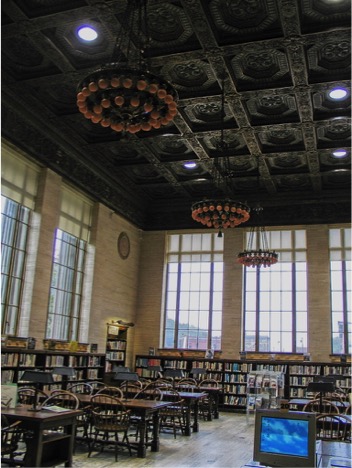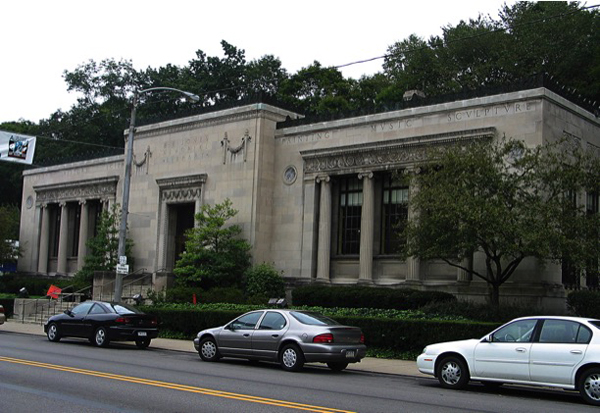
Architecture Feature: B. F. Jones Memorial Library, Aliquippa, Pa.
“Classic Lines, Sufficiently Modern, a Charming Freshness, and Dignity of Style”: B. F. Jones Memorial Library, Aliquippa, Pa.
By Albert Tannler
Adhering strikingly to the classic lines of the Renaissance, The B. F. Jones Memorial Library is nevertheless sufficiently modern in its treatment to suggest a charming freshness which in no way detracts from its dignity of style.— Programme of the Presentation and Dedication of B. F. Jones Memorial Library. Aliquippa, Pennsylvania, February 1, 1929
Angelique Bamberg notes:
The present City of Aliquippa was created from the merger of the towns of Woodlawn and Aliquippa in 1928. . . . The city’s history is closely tied to that of the Pittsburgh & Lake Erie Railroad (P&LERR) and the Jones & Laughlin Steel Company. The P&LERR’s line from Pittsburgh to Youngstown, OH was completed in 1879. To encourage passenger traffic from both cities, the railroad opened an amusement park, Aliquippa Park, roughly equidistant between them in 1880. The name Aliquippa was chosen by the President of the P&LERR, who had an interest in Native American history; Queen Aliquippa was a leader of the Seneca Tribe in the 18th century. There is no evidence of a direct association between the historical figure of Aliquippa and the town site, however.[1]
The Building and the Donor
 According to the National Register Nomination Form, “the library serves as a fitting memorial for one of the industrial giants and cofounders of Jones & Laughlin Steel Corporation, Benjamin Franklin Jones, Sr. [1824-1903] His contributions, along with those of his family and associates, are part of the history of steel making and the socio-economic impact which resulted from J&L’s growth. His daughter, Mrs. Elisabeth McMasters (Jones) Horne, recognizing the importance of individual development, offered to erect a library more responsive to the needs of the public. Her generous gift to the community has probably had as much effect on the growth and development of the community as did the steel plant several blocks away.”[2]
According to the National Register Nomination Form, “the library serves as a fitting memorial for one of the industrial giants and cofounders of Jones & Laughlin Steel Corporation, Benjamin Franklin Jones, Sr. [1824-1903] His contributions, along with those of his family and associates, are part of the history of steel making and the socio-economic impact which resulted from J&L’s growth. His daughter, Mrs. Elisabeth McMasters (Jones) Horne, recognizing the importance of individual development, offered to erect a library more responsive to the needs of the public. Her generous gift to the community has probably had as much effect on the growth and development of the community as did the steel plant several blocks away.”[2]
The National Register of Historic Places Inventory––Nomination Form of 1974 gives a detailed listing of the elements of the building while noting: “The interior has been little altered although some rooms are no longer used for the purposes for which they were designed.”[3]
The February 1, 1929 Programme of the Presentation and Dedication of B. F. Jones Memorial Library, gives a sense of character of the building:
The library building . . . is remarkable not alone for its architectural beauty. The entire structure reflects the thoroughness with which the project was studied long before erection, in order that the completed building might lend itself in every way to the work and service to be accomplished. Consequently, one finds book stacks, work rooms, rest rooms, a librarians office, an exhibition room, furniture, filing cases and other carefully selected equipment, all so favorable [sic] situated and co-ordinated that the building is practically perfect as to workability. Building materials include “grey Indiana limestone . . . Kasota marble . . . and Travertine from Italy.”
The Architect and the Artists
Brandon Smith was among a handful of the most talented eclectic architects to have practiced in western Pennsylvania. One of the last in a noted generation of traditionalists, his work at Fox Chapel Golf Club, The Edgeworth Club, and on a series of fine residential designs are distinguished by thoughtful accommodation and unfailingly gracious resolution. He is deservedly remembered as Pittsburgh’s most sought after high society architect.
Smith was born in Allegheny City in 1889. His parents were Charles O. and Elizabeth Benn Smith. His family was of German and English descent and his father owned the Sterling White Lead Co., which was later sold to the National Lead Co.
Brandon graduated from the old Central High School, his first job was demonstrating roadsters and early automobiles. He attended architectural classes at Carnegie Tech in the years 1910 – 1912. He was a student of unmistakable talent and sophistication, but he never graduated from the program. He enlisted in the Army in 1917 and served as Lieutenant in the Field Artillery during World War I.
While stationed in Salt Lake, Utah, he met and later married Kate Nelson. They had two daughters, Marian and Barbara.
It’s important to note that early in his career Brandon worked in the office of Alden & Harlow. From 1920 – 1927 Brandon worked in partnership with Paul A. Bartholomew, a University of Pennsylvania graduate who had also worked at Alden & Harlow. Bartholomew & Smith had offices in Pittsburgh and Greensburg.[4]
The years of the Great Depression and the Second World War were very hard on architectural careers and Brandon despaired that the profession would never recover. During the war years some of his beautiful drawings for designs that would never be built were exhibited by the Pittsburgh Architectural Club, and by the Associated Artists of Pittsburgh. He remained a traditionalist, opposed modernist ideas, and retired to Florida in 1955. There he also designed a few buildings, and died in Pensacola in 1962 at the age of 72. He is buried in Arlington Cemetery.[5]
David Vater observes that “the B.F. Jones Memorial Library at 603 Franklin Street in Aliquippa, PA . . . is without question the finest building in this once prosperous steel town. . . . It’s well worth a visit.” The National Register of Historic Places form notes that “Three large 30 light windows are set behind the recessed columns. . . The side elevations each have three windows of 30 lights.” David Vater quotes Smith’s daughter who observed that her father “always insisted upon driving convertibles because he was a claustrophobic, like the bright yellow Nash and a little green MG he used to race about in. Perhaps his claustrophobia was the motive for the generous fenestration and a preoccupation with openness in many of his architectural designs.”[6]
Artwork in the library consists of a larger-than-life bronze and marble statue of B. F. Jones by Robert Aiken of New York City; the color scheme in the building was planned by Norah Thorpe of New York City; Mrs. Horne’s portrait is by Dutch portrait painter Alfred Hoen; and the leaded glass windows are by Henry Hunt of Hunt Studios, Pittsburgh.
Bibliography
Programme of the Presentation and Dedication of B. F. Jones Memorial Library. Aliquippa, Pennsylvania, February 1, 1929.
50th Anniversary, B.F. Jones Memorial Library 1929-1979. Aliquippa, Pennsylvania.
- F. Jones Memorial Library, National Register of Historic Places Inventory––Nomination Form. Placed on the NRHP on December 15, 1974.
Vater, David J. “Brandon Smith, Eclectic Architect.” Fox Chapel Golf Club, October 2, 2005.
Bamberg, Angelique. “An Architectural Inventory, Franklin Avenue Aliquippa, PA. Report of Findings and Recommendations.” Prepared for the Community Development Program of Beaver County in cooperation with Pennsylvania State Historic Preservation Office by Clio Consulting, June 12, 2016.
[1] Angelique Bamberg, An Architectural Inventory, Franklin Avenue Aliquippa, Pa, 3.
[2] “B. F. Jones Memorial Library,” National Register of Historic Places Inventory-Nomination Form, n.p.
[3] Ibid.
[4] David Vater notes that Smith later partnered with Harold O. Rief, with offices in downtown Pittsburgh.
[5] Vater, “Brandon Smith, Eclectic Architect,” 2005.
[6] Ibid.

